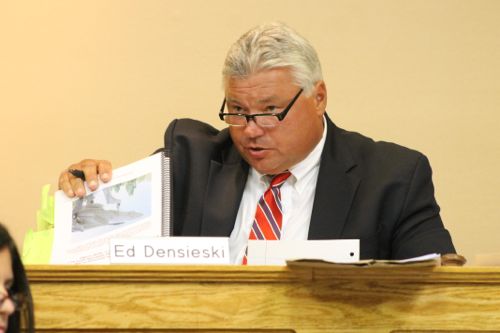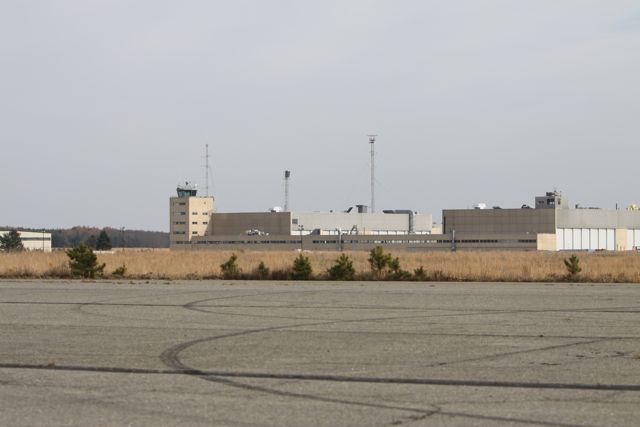The Riverhead Planning Board last night gave its non-binding blessing to the town board’s “conceptual” subdivision map of town-owned acreage in the Enterprise Park at Calverton.
The planning board, which by state law has sole authority to approve land subdivisions within the township, has been reviewing the map since the town board asked it to weigh in on it last year.
The referral was a deviation from the planning board’s usual process, which ordinarily begins with a sketch plan. It is also extraordinary because the lines depicted on the map do not necessarily show the actual lots that will eventually be carved out of the town-owned 2,324 acres. The town board is considering adopting “form-based” zoning for the site, which outlines, in broad strokes, the uses that will be allowed within the site but doesn’t apply them to individual lots until prospective developers apply for approvals. The process is further complicated by the fact that neither the final environmental impact statement required under the State Environmental Quality Review Act nor the rezoning have yet been completed by the town board.
In discussions over the past several months, planning board members have grappled with the form-based zoning concept and moving forward in the unusual order of procedure.
The resolution adopted last night — over the objection of Ed Densieski, who cast the sole vote against it — is really a “sense of the board” resolution to give the town board assurances that the planning board agrees with the conceptual plan. The town board’s planning consultants will then proceed to prepare a “fully engineered” subdivision map for submission to the he planning board and the other appropriate agencies, including the county health department, State Department of Transportation and the State Department of Environmental Conservation.
While the DEC does not have jurisdiction over subdivision approval per se, it has jurisdiction to protect endangered species and wildlife habitat. Riverhead Town must obtain permits from the wetlands, Wild Scenic and Recreational Rivers Act and “incidental take” permits from the DEC. For that reason, the EPCAL subdivision process effectively started with the DEC rather than the town planning board, the town’s special counsel, Frank Isler, told the board.
“They have formally approved where the management of the wildlife areas have been demarced and the map grew from that,” Isler said.
Town officials, lawyers and planning consultants spent more than a year negotiating with state environmental regulators the extent and location of grasslands to be preserved or replaced as habitat for threatened species observed at the site during an extensive inventorying process undertaken by the town in connection with the environment impact statement.
With “conceptual approval” of the planning board and the DEC’s approval of the wildlife areas, the town will move forward with more detailed maps.
“You’re taking a chance on that,” member Joseph Baier told Isler.
“We have a very strong sense” of what the DEC wants, Isler said. “Their focus is on wildlife areas,” he said. “Now we’re going to go before the DEC to review their final comments” on the town’s supplemental generic environmental impact statement,” he said. “This resolution is a major step toward getting the final engineering work done with comfort, at least from a design standpoint.”

Before casting his dissenting vote, Densieski criticized the resolution as “untimely” and said it has no meaning.
“As Joe [Baier] said at the last meeting, this is putting the cart before the horse,” Densieski said. “The SEQRA is not done yet. The zoning is not done. What’s the rush? It’s going to be years before there’s any real action there. So why not wait and get it right? Our rather pricey consultant, VHB, couldn’t or wouldn’t answer my questions. They sort of took the Fifth Amendment approach,” he said, referring to the planning board’s April 16th work session with representatives of the consulting firm.
Densieski has roundly criticized the updated reuse plan for the site for allowing limited retail and residential uses. The former town councilman has long been an adamant opponent of residential uses at the former Grumman site. Although the residential uses are supposed to be limited to housing to support industrial or hi-tech uses on the site, Densieski’s not buying it.
“The subdivision infrastructure is going to cost about $55 million,” he said. “Does anybody really see that happening? If Riverhead can’t afford to do that infrastructure, what other scenarios can we foresee?
“I can see developers buying the lots and building 300 as-of-right houses,” Densieski said. “Housing is a tax negative. With this plan, my prediction is you’ll see more school buses at EPCAL than visiting scientists,” he said.
Densieski also predicted that “the DEC will receive this, promptly stamp it incomplete and put it in a pile somewhere.”
Stan Carey noted that “a lot of work and planning with DEC” went into the map being considered by the board.
“From what we’ve been advised, they are in agreement with this layout,” Carey said. “If we shoot it down and the town has to go back to them, it could take another 20 years. The town is not in a position to wait that long. I’d hate to see us go back to drawing board with the DEC,” Carey said. “I’m supporting this and voting yes.”
The planning board’s newest member, George Nunnaro, said he agreed with Carey. “I don’t want to see it set back.”
Baier voted yes without comment as did the chairman Richard O’Dea.
The town will be meeting with the DEC in the next week or so to review the agency’s last round of comments on the environmental impact statement, Isler said. The town board also needs to complete and adopt the final supplemental generic environmental impact statement and a “findings statement,” the last step in the environmental review process.
Town board hearing on proposed zoning set for May 20
Meanwhile, the town board has scheduled a 7:10 p.m. May 20 public hearing on a proposed new section of the Riverhead zoning code to regulate use and development of land at the enterprise park: article LXIII of chapter 108, titled “Planned Development District.” The new code is intended to implement the town’s adopted reuse plan for the site as well as a state law passed in 2013 providing for expedited approval of development applications that conform to the adopted plan.
The proposed zoning would permit, as principal uses on the site, “all uses that promote economic development” in the new PD district.
It would specifically prohibit garbage disposal dumps, landfills, incinerators or transfer stations; gas stations and gas manufacture from coal, coke, or petroleum; petroleum and/or kerosene distillations or refining and storage facilities; sand, gravel, mineral quarrying and mining; motor vehicle, boat, and equipment dismantling, wrecking, and compacting; outdoor sale or storage of motor vehicles, boats, and equipment except by special permit of the town; manufacture, warehousing, wholesaling, sale and storage of hazardous, dangerous, explosive material, including ammunition, acids; and any use which generates offensive noise, vibration, dust, smoke, gas or other nuisances shall be prohibited.
It would allow, as “supportive uses” on the site “a limited number of attached residential units” and “retail, personal service or restaurant uses specifically designed to support permitted principal or other supportive uses” on the site.

EPCAL history in a nutshell
The Enterprise Park at Calverton was once the home of Grumman Aerospace Corp., which beginning in the early 1950s manufactured, assembled and tested military aircraft on a 2,900-acre site owned by the U.S. Navy. Grumman fighter planes built in Calverton included as the supersonic F14 Tomcat and the A-6E Intruder. When Grumman moved out of the facility in 1996, Riverhead lost 3,000 jobs and $1 million a year in real estate tax revenues (technically payments in lieu of taxes, known as PILOT payments, because the land was government-owned and tax exempt.)
Legislation authorizing the transfer of the site to the town was passed by Congress in 1994, after word of the impending closure was made public. The Navy deeded the site to the town in 1998, after the town had developed a reuse plan required by the federal government as a condition of transfer.
The town sold the 491-acre “industrial core” of the site to developer Jan Burman for $17 million in 2001. Since then it has struggled with the redevelopment of the remaining mostly vacant land, much of it zoned for recreational and entertainment uses pursuant to a reuse plan adopted in 1996
On taking office in 2010, Riverhead Supervisor Sean Walter vowed to pursue a different approach at EPCAL. After the demise of a contract to sell 755 acres to a developer proposing to build a themed resort park that included an indoor ski mountain, Walter pushed for the town to develop a new comprehensive land use plan for the site and to pursue a subdivision of the remaining town-owned acreage that would allow the town to sell off smaller-sized lots. A trip to Devens, Mass. in January 2011 sparked the idea for a state commission with omnibus permitting authority at EPCAL. That evolved into state legislation authorizing an expedited review process for development at EPCAL subject to certain conditions. The town hired VHB Engineering, Surveying and Landscape Architecture in February 2011 to update the 1996 reuse plan, prepare a supplemental generic environmental impact statement, handle the subdivision and draft new zoning.
The survival of local journalism depends on your support.
We are a small family-owned operation. You rely on us to stay informed, and we depend on you to make our work possible. Just a few dollars can help us continue to bring this important service to our community.
Support RiverheadLOCAL today.
































